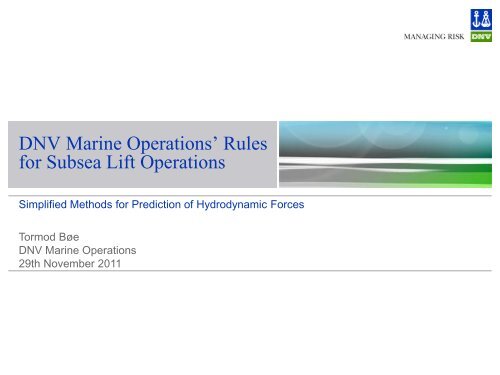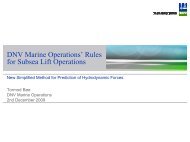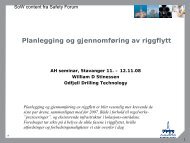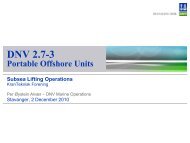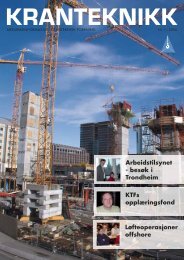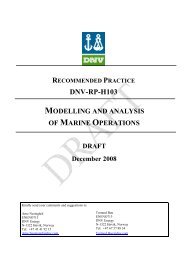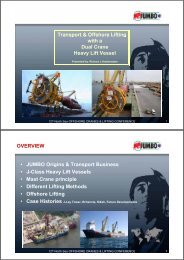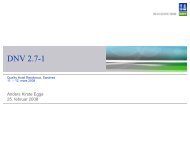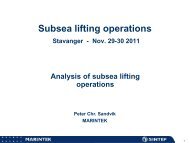DNV Marine Operations' Rules for Subsea Lift Operations
DNV Marine Operations' Rules for Subsea Lift Operations
DNV Marine Operations' Rules for Subsea Lift Operations
- No tags were found...
You also want an ePaper? Increase the reach of your titles
YUMPU automatically turns print PDFs into web optimized ePapers that Google loves.
<strong>DNV</strong> <strong>Marine</strong> <strong>Operations</strong>’ <strong>Rules</strong><strong>for</strong> <strong>Subsea</strong> <strong>Lift</strong> <strong>Operations</strong>Simplified Methods <strong>for</strong> Prediction of Hydrodynamic ForcesTormod Bøe<strong>DNV</strong> <strong>Marine</strong> <strong>Operations</strong>29th November 2011
Content• Brief overview of relevant <strong>DNV</strong> publications• <strong>DNV</strong> <strong>Rules</strong> <strong>for</strong> <strong>Marine</strong> <strong>Operations</strong>, 1996,Pt.2 Ch.5 <strong>Lift</strong>ing – Capacity Checks• Simplified Methods <strong>for</strong> prediction of Hydrodynamic Forceso in Splash Zone, <strong>DNV</strong>-RP-H103 Ch.4o in Deepwater, <strong>DNV</strong>-RP-H103 Ch.5<strong>DNV</strong> <strong>Marine</strong> <strong><strong>Operations</strong>'</strong> <strong>Rules</strong> <strong>for</strong> <strong>Subsea</strong> <strong>Lift</strong> <strong>Operations</strong> 29. November 2011Slide 2
Relevant <strong>DNV</strong> Publications<strong>Lift</strong>ing- and subsea operations :<strong>DNV</strong> <strong>Rules</strong> <strong>for</strong> Planning and Execution of<strong>Marine</strong> <strong>Operations</strong> – 1996 and<strong>DNV</strong>-OS-H101 <strong>Marine</strong> <strong>Operations</strong>, General - 2011’Specially planned, non-routine operations oflimited durations, at sea. <strong>Marine</strong> operations arenormally related to temporary phases as e.g.load transfer, transportation and installation.’<strong>DNV</strong>-OS-E402 OffshoreStandard <strong>for</strong> Diving SystemsOctober 2010<strong>DNV</strong> Standard <strong>for</strong> CertificationNo.2.22 <strong>Lift</strong>ing AppliancesOctober 2011<strong>DNV</strong> Standard <strong>for</strong> CertificationNo. 2.7-3 Portable Offshore UnitsMay 2011Specially planned non-routine operationsRoutine operations<strong>DNV</strong> <strong>Marine</strong> <strong><strong>Operations</strong>'</strong> <strong>Rules</strong> <strong>for</strong> <strong>Subsea</strong> <strong>Lift</strong> <strong>Operations</strong> 29. November 2011Slide 3
Relevant <strong>DNV</strong> Publications - Other• <strong>DNV</strong>-RP-C205 Environmental Conditionsand Environmental Loads October 2010• <strong>DNV</strong>-RP-H101 Risk Management in<strong>Marine</strong> and <strong>Subsea</strong> <strong>Operations</strong>, January2003• <strong>DNV</strong>-RP-H102 <strong>Marine</strong> <strong>Operations</strong> duringRemoval of Offshore Installations,April 2004• <strong>DNV</strong>-RP-H103 Modelling and Analysis of<strong>Marine</strong> <strong>Operations</strong>, April 2011<strong>DNV</strong> <strong>Marine</strong> <strong><strong>Operations</strong>'</strong> <strong>Rules</strong> <strong>for</strong> <strong>Subsea</strong> <strong>Lift</strong> <strong>Operations</strong> 29. November 2011Slide 4
Content• Brief overview of relevant <strong>DNV</strong> publications• <strong>DNV</strong> <strong>Rules</strong> <strong>for</strong> <strong>Marine</strong> <strong>Operations</strong>, 1996,Pt.2 Ch.5 <strong>Lift</strong>ing – Capacity Checks• Simplified Methods <strong>for</strong> prediction of Hydrodynamic Forceso in Splash Zone, <strong>DNV</strong>-RP-H103 Ch.4o in Deepwater, <strong>DNV</strong>-RP-H103 Ch.5<strong>DNV</strong> <strong>Marine</strong> <strong><strong>Operations</strong>'</strong> <strong>Rules</strong> <strong>for</strong> <strong>Subsea</strong> <strong>Lift</strong> <strong>Operations</strong> 29. November 2011Slide 6
Capacity Checks - <strong>DNV</strong> 1996 <strong>Rules</strong>Part 2 Chapter 5• Dynamic loads, lift in air• Crane capacity• Rigging capacity,(slings, shackles, etc.)• Structural steel capacity(lifted object, lifting points,spreader bars, etc.)Dynamic loads <strong>for</strong> subsea lifts are estimated according to <strong>DNV</strong>-RP-H103<strong>DNV</strong> <strong>Marine</strong> <strong><strong>Operations</strong>'</strong> <strong>Rules</strong> <strong>for</strong> <strong>Subsea</strong> <strong>Lift</strong> <strong>Operations</strong> 29. November 2011Slide 7
Capacity Checks – DAF <strong>for</strong> <strong>Lift</strong> in Air• Dynamic loads are accounted <strong>for</strong> byusing a Dynamic Amplification Factor(DAF).• DAF in air may be caused by e.g.variation in hoisting speeds or motionsof crane vessel and lifted object.• The given table is applicable <strong>for</strong>offshore lift in air in minor sea states,typically Hs < 2-2.5m.• DAF must be estimated separately <strong>for</strong>lifts in air at higher seastates and <strong>for</strong>subsea lifts !Table 2.1 Pt.2 Ch.5 Sec.2.2.4.4<strong>DNV</strong> <strong>Marine</strong> <strong><strong>Operations</strong>'</strong> <strong>Rules</strong> <strong>for</strong> <strong>Subsea</strong> <strong>Lift</strong> <strong>Operations</strong> 29. November 2011Slide 8
Capacity Checks - Crane CapacityThe dynamic hook load, DHL, isgiven by:DHL = DAF*(W+Wrig) + F(SPL)ref. Pt.2 Ch.5 Sec.2.4.2.1• W is the weight of the structure,including a weight inaccuracy factor• The DHL should be checked againstavailable crane capacity• The crane capacity decrease whenthe lifting radius increase.<strong>DNV</strong> <strong>Marine</strong> <strong><strong>Operations</strong>'</strong> <strong>Rules</strong> <strong>for</strong> <strong>Subsea</strong> <strong>Lift</strong> <strong>Operations</strong> 29. November 2011Slide 9
Capacity Checks - Sling LoadsThe maximum dynamic sling load, Fsling,can be calculated by:Example :Fsling = DHL∙SKL∙kCoG∙DW / sin φref. Pt.2 Ch.5 Sec.2.4.2.3-6where:• SKL = Skew load factor → extra loadingcaused by equipment and fabrication tolerances.• kCoG = CoG factor → inaccuracies in estimatedposition of centre of gravity.• DW = vertical weight distribution → e.g.DWA = (8/15)∙(7/13) in sling A.• φ = sling angle from the horizontal plane.<strong>DNV</strong> <strong>Marine</strong> <strong><strong>Operations</strong>'</strong> <strong>Rules</strong> <strong>for</strong> <strong>Subsea</strong> <strong>Lift</strong> <strong>Operations</strong> 29. November 2011Slide 10
Capacity Checks - Slings and ShacklesThe sling capacity ”Minimum breaking load”,MBL, is checked by:FslingMBLγsfslingThe safety factor is minimum sf ≥ 3.0.(Pt.2 Ch.5 Sec.3.1.2)”Safe working load”, SWL, and ” MBL, of theshackle are checked by :a) F sling < SWL∙ DAFand b) F sling < MBL / 3.3Both criteria shall be fulfilled (Pt.2 Ch.5 Sec.3.2.1.2)<strong>DNV</strong> <strong>Marine</strong> <strong><strong>Operations</strong>'</strong> <strong>Rules</strong> <strong>for</strong> <strong>Subsea</strong> <strong>Lift</strong> <strong>Operations</strong> 29. November 2011Slide 11
Capacity Checks – Structural Steel<strong>Lift</strong>ing points:The load factor f = 1.3, is increased by aconsequence factor, C = 1.3, so that totaldesign faktor, design , becomes:design = c∙ f = 1.3 ∙ 1.3 = 1.7The design load acting on the lift point becomes:Other lifting equipment:A consequence factor of C = 1.3should be applied on lifting yokes,spreader bars, plateshackles, etc.Structural strength of <strong>Lift</strong>ed Object:The following consequence factorsshould be applied :Fdesign = design∙ Fsling = 1.7∙ FslingA lateral load ofminimum 3% of thedesign load shall beincluded. This loadacts in the shacklebow !(ref. Pt.2.Ch.5 Sec.2.4.3.4)Table 4.1Pt.2 Ch.5 Sec.4.1.2<strong>DNV</strong> <strong>Marine</strong> <strong><strong>Operations</strong>'</strong> <strong>Rules</strong> <strong>for</strong> <strong>Subsea</strong> <strong>Lift</strong> <strong>Operations</strong> 29. November 2011Slide 12
Capacity Checks – SummaryCheckComputeApplyDAF• <strong>Lift</strong> in air: VMO <strong>Rules</strong> Pt.2 Ch.5• <strong>Subsea</strong> lift: <strong>DNV</strong>-RP-H103CranecapacityDHL• Weight of lifted objectand lifting equipmentCapacityof liftingequipmentF sling• Skew load, CoG and sling angle• Safety factors<strong>DNV</strong> <strong>Marine</strong> <strong><strong>Operations</strong>'</strong> <strong>Rules</strong> <strong>for</strong> <strong>Subsea</strong> <strong>Lift</strong> <strong>Operations</strong> 29. November 2011Slide 13
Content• Brief overview of relevant <strong>DNV</strong> publications• <strong>DNV</strong> <strong>Rules</strong> <strong>for</strong> <strong>Marine</strong> <strong>Operations</strong>, 1996,Pt.2 Ch.5 <strong>Lift</strong>ing – Capacity Checks• Simplified Methods <strong>for</strong> prediction of Hydrodynamic Forceso in Splash Zone, <strong>DNV</strong>-RP-H103 Ch.4o in Deepwater, <strong>DNV</strong>-RP-H103 Ch.5<strong>DNV</strong> <strong>Marine</strong> <strong><strong>Operations</strong>'</strong> <strong>Rules</strong> <strong>for</strong> <strong>Subsea</strong> <strong>Lift</strong> <strong>Operations</strong> 29. November 2011Slide 14
Simplified Method, Splash Zone - <strong>DNV</strong>-RP-H103• The Recommended Practice; ”<strong>DNV</strong>-RP-H103 Modelling and Analysis of <strong>Marine</strong><strong>Operations</strong>” was issued april 2009. Latestrevision is april 2011.• A Simplified Method <strong>for</strong> calculatinghydrodynamic <strong>for</strong>ces on objects liftedthrough wave zone is included in chapter 4.• This Simplified Method supersedes thecalculation guidelines in <strong>DNV</strong> <strong>Rules</strong> <strong>for</strong><strong>Marine</strong> <strong>Operations</strong>, 1996, Pt.2 Ch.6.<strong>DNV</strong> <strong>Marine</strong> <strong><strong>Operations</strong>'</strong> <strong>Rules</strong> <strong>for</strong> <strong>Subsea</strong> <strong>Lift</strong> <strong>Operations</strong> 29. November 2011Slide 15
Simplified Method, Splash Zone - AssumptionsThe Simplified Method is based upon thefollowing main assumptions:• the horizontal extent of the lifted object issmall compared to the wave length• the vertical motion of the object is equal thevertical crane tip motion• vertical motion of object and water dominates→ other motions can be disregardedThe intention of the Simplified Method is togive simple conservative estimates of the<strong>for</strong>ces acting on the object.<strong>DNV</strong> <strong>Marine</strong> <strong><strong>Operations</strong>'</strong> <strong>Rules</strong> <strong>for</strong> <strong>Subsea</strong> <strong>Lift</strong> <strong>Operations</strong> 29. November 2011Slide 16
New Simplified Method - AssumptionsTime-domain analysis:• Coupled multi-bodysystems with individual<strong>for</strong>ces and motions.• Wind, wave and current<strong>for</strong>ces.• Geometry modelled.• Motions <strong>for</strong> all degreesof freedom computed.• Non-linearities included.• Coupling effects.• Continous loweringsimulations.• Varying added mass.• Statistical analysis ofresponses.• Visualization of lift.<strong>DNV</strong> <strong>Marine</strong> <strong><strong>Operations</strong>'</strong> <strong>Rules</strong> <strong>for</strong> <strong>Subsea</strong> <strong>Lift</strong> <strong>Operations</strong> 29. November 2011Slide 17
Simplified Method, Splash Zone - Crane Tip Motions• The Simplified Method is unapplicable if the crane tiposcillation period or the wave period is close to theresonance period, Tn , of the hoisting systemMKAT33n 2• Heave, pitch and roll RAOs <strong>for</strong>the vessel should be combinedwith crane tip position to findthe vertical motion of the crane tip• If operation reference period iswithin 30 minutes, the mostprobable largest responses maybe taken as 1.80 times thesignificant responses• Unless the vessel heading isfixed, vessel response should beanalysed <strong>for</strong> wave directions atleast ±15° off the applied vesselheading<strong>DNV</strong> <strong>Marine</strong> <strong><strong>Operations</strong>'</strong> <strong>Rules</strong> <strong>for</strong> <strong>Subsea</strong> <strong>Lift</strong> <strong>Operations</strong> 29. November 2011Slide 18
Simplified Method, Splash Zone - Wave PeriodsThere are two alternative approaches:Alt-1) Wave periods are included:Analyses should cover the following zerocrossingwave period range:H s8.9 Tzg13A lower limit of Hmax=1.8·Hs=λ/7 withwavelength λ=g·T z 2 /2π is here used.Alt-2) Wave periods are disregarded:Operation procedures should in this case reflect that the calculations are only valid <strong>for</strong>waves longer than:Tz 10. 6 HgSA lower limit of Hmax=1.8·Hs=λ/10 with wavelengthλ=g·T z 2 /2π is here used.<strong>DNV</strong> <strong>Marine</strong> <strong><strong>Operations</strong>'</strong> <strong>Rules</strong> <strong>for</strong> <strong>Subsea</strong> <strong>Lift</strong> <strong>Operations</strong> 29. November 2011Slide 19
Simplified Method, Splash Zone - Wave KinematicsAlt-1) Wave periods are included:The wave amplitude, wave particlevelocity and acceleration can be taken as:• aH Sv• wa• w 0. 9 aa 2eT z 2 T z 2e42dT2zTg42d2zg• d : distance from water plane to CoG ofsubmerged part of objectAlt-2) Wave periods are disregarded:The wave particle velocity and acceleration canbe taken as:v• wa• w0.30 g Hs0.10g ee0.35dHs0.35dHs<strong>DNV</strong> <strong>Marine</strong> <strong><strong>Operations</strong>'</strong> <strong>Rules</strong> <strong>for</strong> <strong>Subsea</strong> <strong>Lift</strong> <strong>Operations</strong> 29. November 2011Slide 20
Simplified Method, Splash Zone - Hydrodynamic ForcesSlamming impact <strong>for</strong>ceSlamming <strong>for</strong>ces are short-term impulse<strong>for</strong>ces that acts when the structure hits thewater surface.A S is the relevant slamming area on theexposed structure part. Cs is slamming coeff.The slamming velocity, v s , is :vsvcv2ctv2w• vc = lowering speed• vct = vertical crane tip velocity• vw = vertical water particle velocityat water surfaceVarying buoyancy <strong>for</strong>ceVarying buoyancy, Fρ , is the change inbuoyancy due to the water surfaceF V gelevation.δV is the change in volume of displacedwater from still water surface to wave crestor wave trough.FV V g~A w2a2ct• ζa = wave amplitude• ηct = crane tip motion amplitude• Ãw = mean water line area in thewave surface zone<strong>DNV</strong> <strong>Marine</strong> <strong><strong>Operations</strong>'</strong> <strong>Rules</strong> <strong>for</strong> <strong>Subsea</strong> <strong>Lift</strong> <strong>Operations</strong> 29. November 2011Slide 21
Simplified Method, Splash Zone - Hydrodynamic ForcesDrag <strong>for</strong>ceDrag <strong>for</strong>ces are flow resistance on submergedpart of the structure. The drag <strong>for</strong>ces arerelated to relative velocity between object andwater particles.The drag coefficient, CD, in oscillatory flow <strong>for</strong>complex subsea structures may typically beCD ≥ 2.5.Relative velocity are found by :Mass <strong>for</strong>ce“Mass <strong>for</strong>ce” is here a combination of inertia<strong>for</strong>ce, Froude-Kriloff <strong>for</strong>ce and diffraction<strong>for</strong>ce.Crane tip acceleration and water particleacceleration are assumed statisticallyindependent.Fvrvcv2ctv2w• vc = lowering/hoisting speed• vct = vertical crane tip velocity• vw = vertical water particle velocityat water depth , d• Ap = horizontal projected areaM2M A a V A a 233 ct33 w• M = mass of object in air• A33 = heave added mass of object• act = vertical crane tip acceleration• V = volume of displaced water relative tothe still water level• aw = vertical water particle accelerationat water depth, d<strong>DNV</strong> <strong>Marine</strong> <strong><strong>Operations</strong>'</strong> <strong>Rules</strong> <strong>for</strong> <strong>Subsea</strong> <strong>Lift</strong> <strong>Operations</strong> 29. November 2011Slide 22
Simplified Method, Splash Zone - BasicsProperties:• Mass, M [kg]• Volume, V [m 3 ]• Added mass, A 33 [kg]Forces:• Weight [N]• Buoyancy [N]Weight = M*g moonBuoyancy = ρ*V*gWeight = M*g<strong>DNV</strong> <strong>Marine</strong> <strong><strong>Operations</strong>'</strong> <strong>Rules</strong> <strong>for</strong> <strong>Subsea</strong> <strong>Lift</strong> <strong>Operations</strong> 29. November 2011Slide 23
Simplified Method, Splash Zone - Added MassHydrodynamic added mass <strong>for</strong> flat platesExample:Flat plate wherelength, b, abovebreadth, a, isb/a = 2.0 : 2A33 0.76 a b4<strong>DNV</strong> <strong>Marine</strong> <strong><strong>Operations</strong>'</strong> <strong>Rules</strong> <strong>for</strong> <strong>Subsea</strong> <strong>Lift</strong> <strong>Operations</strong> 29. November 2011Slide 24
A33/A33oSimplified Method, Splash Zone - Added MassAdded Mass Increase due to Body HeightAdded Mass Increase due to Body HeightThe following simplified approximation of theadded mass in heave <strong>for</strong> a three-dimensionalbody with vertical sides may be applied :2 1A 33 1 A2 33o2(1 ) and h ApAp1.81.71.61.51.41.31.21.111+SQRT((1-lambda^2)/(2*(1+lambda^2)))0 0.5 1 1.5 2 2.5ln [ 1+ (h/sqrt(A)) ]where• A33o = added mass <strong>for</strong> a flat plate with ashape equal to the horizontal projectedarea of the object• h = height of the object• Ap = horizontal projected area of the object<strong>DNV</strong> <strong>Marine</strong> <strong><strong>Operations</strong>'</strong> <strong>Rules</strong> <strong>for</strong> <strong>Subsea</strong> <strong>Lift</strong> <strong>Operations</strong> 29. November 2011Slide 25
Simplified Method, Splash Zone - Added MassAdded Mass from Partly Enclosed VolumeA volume of water partlyenlosed within large platedsurfaces will also contributeto the added mass, e.g.:• The volume of waterinside suction anchorsor foundation buckets.• The volume of waterbetween large platedmudmat surfaces androof structures.<strong>DNV</strong> <strong>Marine</strong> <strong><strong>Operations</strong>'</strong> <strong>Rules</strong> <strong>for</strong> <strong>Subsea</strong> <strong>Lift</strong> <strong>Operations</strong> 29. November 2011Slide 26
Added Mass Reduction FactorSimplified Method, Splash Zone - Added MassAdded Mass Reduction due to Per<strong>for</strong>ationRecommended reduction:AAAA33 33S3333SAA3333S1.0 0.7 0.3cos (p 5 ) / e10p28if p< 534if 5 < p < 34if 34 < p < 50A 33S = added mass <strong>for</strong> a nonper<strong>for</strong>atedstructure.10.90.80.70.60.50.40.30.20.10Effect of per<strong>for</strong>ation on added mass.e^-P/28BucketKC0.1-H4D-NiMoBucketKC0.6-H4D-NiMoBucketKC1.2-H4D-NiMoBucketKC0.5-H0.5D-NiMoBucketKC1.5-H0.5D-NiMoBucketKC2.5-H0.5D-NiMoBucketKC3.5-H0.5D-NiMoPLET-KC1-4Roof-A0.5-2.5+Hatch20-KCp0.5-1.8Hatch18-KCp0.3-0.8BucketKC0.1BucketKC0.6BucketKC1.2RoofKCp0.1-0.27RoofKCp0.1-0.37<strong>DNV</strong>-CurveMudmat CFDPer<strong>for</strong>ation0 10 20 30 40 50• No reduction applied in added mass when per<strong>for</strong>ation is small. A significant drop in theadded mass <strong>for</strong> larger per<strong>for</strong>ation rates. Reduction factor applicable <strong>for</strong> p
Simplified Method, Splash Zone - Hydrodynamic ForcesThe hydrodynamic <strong>for</strong>ce is a time dependent function of slamming impact<strong>for</strong>ce, varying buoyancy, hydrodynamic mass <strong>for</strong>ces and drag <strong>for</strong>ces. In theSimplified Method the <strong>for</strong>ces may be combined as follows:Fhyd2( FD Fslam) ( FM F)2• The structure may be divided intomain items and surfaces contributingto the hydrodynamic <strong>for</strong>ce• Water particle velocity andacceleration are related to thevertical centre of gravity <strong>for</strong> eachmain item. Mass and drag <strong>for</strong>cescontributions are then summarized :FM F M iiF D F DiiFMi and FDi are the individual<strong>for</strong>ce contributions from eachmain item<strong>DNV</strong> <strong>Marine</strong> <strong><strong>Operations</strong>'</strong> <strong>Rules</strong> <strong>for</strong> <strong>Subsea</strong> <strong>Lift</strong> <strong>Operations</strong> 29. November 2011Slide 28
Simplified Method, Splash Zone - Load Cases ExampleThe static and hydrodynamic <strong>for</strong>ce should be calculated <strong>for</strong> different stages. Relevantload cases <strong>for</strong> deployment of a protection structure could be:Load Case 1Still water level beneath top of ventilated buckets• Slamming impact <strong>for</strong>ce, Fslam, acts on top ofbuckets. Inertia <strong>for</strong>ce to be included.• Varying buoyancy <strong>for</strong>ce, Fρ , drag <strong>for</strong>ce, FDand hydrodynamic part of mass <strong>for</strong>ce, FM arenegligible.Load Case 2Still water level above top of buckets• Slamming impact <strong>for</strong>ce, Fslam, is zero• Varying buoyancy, Fρ , drag <strong>for</strong>ce, FD andmass <strong>for</strong>ce, FM, are calculated. Velocity andacceleration are related to CoG of submergedpart of structure.<strong>DNV</strong> <strong>Marine</strong> <strong><strong>Operations</strong>'</strong> <strong>Rules</strong> <strong>for</strong> <strong>Subsea</strong> <strong>Lift</strong> <strong>Operations</strong> 29. November 2011Slide 29
Simplified Method, Splash Zone - Load Cases ExampleLoad Case 3Still water level beneath roof cover.• Slamming impact <strong>for</strong>ce, Fslam, acts on the roofcover.• Varying buoyancy, Fρ , drag <strong>for</strong>ce, FD and mass<strong>for</strong>ce, FM are calculated on the rest of thestructure. Drag- and mass <strong>for</strong>ces acts mainly onthe buckets and is related to a depth, d, down toCoG of submerged part of the structure.Load Case 4Still water level above roof cover.• Slamming impact <strong>for</strong>ce, Fslam, and varyingbuoyancy, Fρ, is zero.• Drag <strong>for</strong>ce, FD and mass <strong>for</strong>ce, FM are calculatedindividually. The total mass and drag <strong>for</strong>ce is thesum of the individual load components, e.g. :FD= F Droof + F Dlegs + F Dbuckets applying correct CoGs<strong>DNV</strong> <strong>Marine</strong> <strong><strong>Operations</strong>'</strong> <strong>Rules</strong> <strong>for</strong> <strong>Subsea</strong> <strong>Lift</strong> <strong>Operations</strong> 29. November 2011Slide 30
Simplified Method, Splash Zone - Load Cases Example<strong>DNV</strong> <strong>Marine</strong> <strong><strong>Operations</strong>'</strong> <strong>Rules</strong> <strong>for</strong> <strong>Subsea</strong> <strong>Lift</strong> <strong>Operations</strong> 29. November 2011Slide 31
Simplified Method, Splash Zone - Static Weight• In addition, the weight inaccuracy factor should be applied<strong>DNV</strong> <strong>Marine</strong> <strong><strong>Operations</strong>'</strong> <strong>Rules</strong> <strong>for</strong> <strong>Subsea</strong> <strong>Lift</strong> <strong>Operations</strong> 29. November 2011Slide 32
Simplified Method, Splash Zone - DAFCapacity ChecksThe capacities of crane, lifting equipment andlifted object are checked as <strong>for</strong> lift in air. Thefollowing relation should be applied:DAFFMgtotalwhereMg : weight of object [N]Ftotal : is the characteristic total <strong>for</strong>ce on the(partly or fully) submerged object. Taken as thelargest of;F total = F static-max + F hydF total = F static-max + Fsnapor• Fstatic-max is the maximum staticweight of the submerged objectincluding flooding and weightinaccuracy factor• Fhyd is the hydrodynamic <strong>for</strong>ce• Fsnap is the snap load (normallyto be avoided)<strong>DNV</strong> <strong>Marine</strong> <strong><strong>Operations</strong>'</strong> <strong>Rules</strong> <strong>for</strong> <strong>Subsea</strong> <strong>Lift</strong> <strong>Operations</strong> 29. November 2011Slide 33
Simplified Method, Splash Zone - Slack SlingsThe Slack Sling Criterion.• Snap <strong>for</strong>ces shall as far as possiblebe avoided. Weather crietria shouldbe adjusted to ensure this.• The following criterion should befulfilled in order to ensure that snaploads are avoided:F0.9 hyd F static min• Fstatic-min = weight be<strong>for</strong>e flooding,including a weight reduction impliedby the weight inaccuracy factor.<strong>DNV</strong> <strong>Marine</strong> <strong><strong>Operations</strong>'</strong> <strong>Rules</strong> <strong>for</strong> <strong>Subsea</strong> <strong>Lift</strong> <strong>Operations</strong> 29. November 2011Slide 34
Simplified Method, Splash Zone - Results• Tables can becomputed givingan overview ofoperableseastates• Maximumallowable Fhydis derived frommax allowableDAF and theslack slingcriterion• Red results areaboveinstallation limit• ”Outside” meansnon-existentseastatesHydrodynamic <strong>for</strong>ce on object, FhydTz\Hs 0.5 1.0 1.5 2.0 2.5 3.0 3.5 4.02.0 12.24 Outside Outside Outside Outside Outside Outside Outside2.5 8.33 Outside Outside Outside Outside Outside Outside Outside3.0 6.14 20.45 Outside Outside Outside Outside Outside Outside3.5 4.79 15.54 32.45 Outside Outside Outside Outside Outside4.0 3.89 12.34 25.53 Outside Outside Outside Outside Outside4.5 3.29 10.19 20.89 35.40 53.71 Outside Outside Outside5.0 2.87 8.73 17.76 29.97 45.35 63.92 Outside Outside5.5 2.57 7.70 15.57 26.17 39.52 55.61 74.44 Outside6.0 2.35 6.92 13.90 23.30 35.10 49.32 65.96 85.006.5 2.16 6.27 12.53 20.94 31.49 44.18 59.02 76.017.0 2.00 5.72 11.36 18.92 28.40 39.79 53.10 68.337.5 1.85 5.24 10.34 17.17 25.72 35.98 47.97 61.688.0 1.73 4.82 9.46 15.65 23.39 32.68 43.52 55.918.5 1.62 4.45 8.68 14.32 21.36 29.81 39.66 50.919.0 1.52 4.13 8.01 13.17 19.60 27.31 36.30 46.569.5 1.43 3.84 7.42 12.16 18.06 25.13 33.37 42.7610.0 1.36 3.59 6.90 11.27 16.71 23.22 30.79 39.4410.5 1.29 3.37 6.43 10.48 15.51 21.53 28.52 36.5011.0 1.23 3.17 6.02 9.78 14.45 20.03 26.51 33.9011.5 1.17 2.99 5.66 9.16 13.50 18.69 24.71 31.5812.0 1.12 2.83 5.33 8.60 12.65 17.49 23.10 29.5012.5 1.07 2.69 5.03 8.09 11.89 16.41 21.65 27.6213.0 1.03 2.55 4.75 7.63 11.19 15.42 20.34 25.93<strong>DNV</strong> <strong>Marine</strong> <strong><strong>Operations</strong>'</strong> <strong>Rules</strong> <strong>for</strong> <strong>Subsea</strong> <strong>Lift</strong> <strong>Operations</strong> 29. November 2011Slide 35
Simplified Method, Splash Zone - SummaryCheckNo slackslingsComputeF d, F m,F slam and F ρF hydApply• Object motion equal crane tip• Wave kinematics dependent onassumed Hs,Tz seastate• Different deployment levels• Structure divided in main itemsDAF withincapacityrequirementsDAF<strong>DNV</strong> <strong>Marine</strong> <strong><strong>Operations</strong>'</strong> <strong>Rules</strong> <strong>for</strong> <strong>Subsea</strong> <strong>Lift</strong> <strong>Operations</strong> 29. November 2011Slide 36
Simplified Method, Splash Zone - SummaryThe simplified methodassumes that:• Vertical motion ofstructure is equalto the crane tipmotion.• The horizontalextension of thestructure is small.• Only verticalmotion is present.More accuratecalculations can beper<strong>for</strong>med applying:• Regular designwave approach(Ch. 3.4.2)• Time domainanalyses• CFD analyses<strong>DNV</strong> <strong>Marine</strong> <strong><strong>Operations</strong>'</strong> <strong>Rules</strong> <strong>for</strong> <strong>Subsea</strong> <strong>Lift</strong> <strong>Operations</strong> 29. November 2011Slide 37
Content• Brief overview of relevant <strong>DNV</strong> publications• <strong>DNV</strong> <strong>Rules</strong> <strong>for</strong> <strong>Marine</strong> <strong>Operations</strong>, 1996,Pt.2 Ch.5 <strong>Lift</strong>ing – Capacity Checks• Simplified Methods <strong>for</strong> prediction of Hydrodynamic Forceso in Splash Zone, <strong>DNV</strong>-RP-H103 Ch.4o in Deepwater, <strong>DNV</strong>-RP-H103 Ch.5<strong>DNV</strong> <strong>Marine</strong> <strong><strong>Operations</strong>'</strong> <strong>Rules</strong> <strong>for</strong> <strong>Subsea</strong> <strong>Lift</strong> <strong>Operations</strong> 29. November 2011Slide 38
Deepwater <strong>Operations</strong> - ChallengesChallenges :• Static weight at crane tipincreases linearly with cablelength.• The resonance period of thelifting system increases withcable length. Dynamic <strong>for</strong>cesmay increase due to resonantamplification induced by thevertical crane tip motion.<strong>DNV</strong> <strong>Marine</strong> <strong><strong>Operations</strong>'</strong> <strong>Rules</strong> <strong>for</strong> <strong>Subsea</strong> <strong>Lift</strong> <strong>Operations</strong> 29. November 2011Slide 39
Dynamic Forces – Vertical resonance<strong>DNV</strong> <strong>Marine</strong> <strong><strong>Operations</strong>'</strong> <strong>Rules</strong> <strong>for</strong> <strong>Subsea</strong> <strong>Lift</strong> <strong>Operations</strong> 29. November 2011Slide 40
Simplified Method, Deepwater - Assumptions<strong>DNV</strong>-RP-H103 Chapter 5 includes a simplifiedmethod <strong>for</strong> estimating dynamic response oflowered object.The following main assumptions are applied:• the subsea structure is lowered intodeepwater and is unaffected by wave<strong>for</strong>ces• the vertical motion of crane tip andsubsea structure dominates → othermotions can be disregarded• Offset due to current <strong>for</strong>ces isdisregarded• Heave compensation systems are nottaken into account<strong>DNV</strong> <strong>Marine</strong> <strong><strong>Operations</strong>'</strong> <strong>Rules</strong> <strong>for</strong> <strong>Subsea</strong> <strong>Lift</strong> <strong>Operations</strong> 29. November 2011Slide 41
Case Study – Main Data• The subsea structure mass is 97 tonnes• Water depth is 3000 m• The crane cable is a conventional steel wire• No heave compensation system<strong>DNV</strong> <strong>Marine</strong> <strong><strong>Operations</strong>'</strong> <strong>Rules</strong> <strong>for</strong> <strong>Subsea</strong> <strong>Lift</strong> <strong>Operations</strong> 29. November 2011Slide 42
Case Study – Crane Tip Motion• <strong>Lift</strong> at side ofcrane vessel• Wave heading15° off bow• RAO in heave,pitch and roll arecombined inorder to find thevertical motion atthe crane tip• Vessel’s naturalperiod in roll atT=9s dominates<strong>DNV</strong> <strong>Marine</strong> <strong><strong>Operations</strong>'</strong> <strong>Rules</strong> <strong>for</strong> <strong>Subsea</strong> <strong>Lift</strong> <strong>Operations</strong> 29. November 2011Slide 43
Case Study – Dynamic Load at <strong>Lift</strong>ed Object• Comparison with anon-linear timedomainFE analysis• Dynamicamplification 20%higher at naturalperiod T 0 =9s• Dynamic amp. atT=1.5s due tolongitudinalpressure waves• No wave energy atT=1.5s, hencedeviation isacceptableCable length L=2750m<strong>DNV</strong> <strong>Marine</strong> <strong><strong>Operations</strong>'</strong> <strong>Rules</strong> <strong>for</strong> <strong>Subsea</strong> <strong>Lift</strong> <strong>Operations</strong> 29. November 2011Slide 44
Case Study – Dynamic Load at <strong>Lift</strong>ed Object• Transfer functions<strong>for</strong> dynamic loadin cable andcrane tip motionare combinedwith a wavespectrum S(ω)• Jonswap wavespectrum withHs=2.0m andTp=9s is applied• Most probablelargest response<strong>for</strong> dynamic <strong>for</strong>cein cable is foundby:A duration time t =30 minutesgives F d =530kN in this case<strong>DNV</strong> <strong>Marine</strong> <strong><strong>Operations</strong>'</strong> <strong>Rules</strong> <strong>for</strong> <strong>Subsea</strong> <strong>Lift</strong> <strong>Operations</strong> 29. November 2011Slide 45
Case Study – Dynamic Load at <strong>Lift</strong>ed Object• Calculationsare repeated<strong>for</strong> a range ofseastates• Hs=2.0m givesacceptabledynamic loads<strong>for</strong> all waveperiods• Natural periodof the liftingsystem isT 0 =9s<strong>DNV</strong> <strong>Marine</strong> <strong><strong>Operations</strong>'</strong> <strong>Rules</strong> <strong>for</strong> <strong>Subsea</strong> <strong>Lift</strong> <strong>Operations</strong> 29. November 2011Slide 46
Case Study – Dynamic Load at <strong>Lift</strong>ed Object• Calculations arerepeated <strong>for</strong> arange of cablelengths• Max Fd <strong>for</strong> allTz values• Fd2250mdue to weight ofcableNon-operableseastates<strong>DNV</strong> <strong>Marine</strong> <strong><strong>Operations</strong>'</strong> <strong>Rules</strong> <strong>for</strong> <strong>Subsea</strong> <strong>Lift</strong> <strong>Operations</strong> 29. November 2011Slide 47
Simplified Method, Deepwater - Summary <strong>DNV</strong>-RP-H103 chapter 5 contains a simplified method <strong>for</strong>establishing dynamic loads and limiting weather criteria duringdeepwater lifting operations Most probable largest dynamic load in the lifting line is computedtaking into account dynamic amplification due to resonanceeffects The simplified method is well suited <strong>for</strong> common spreadsheetprograms or other computer software <strong>for</strong> engineeringcalculations.<strong>DNV</strong> <strong>Marine</strong> <strong><strong>Operations</strong>'</strong> <strong>Rules</strong> <strong>for</strong> <strong>Subsea</strong> <strong>Lift</strong> <strong>Operations</strong> 29. November 2011Slide 48
.. Questions ??<strong>DNV</strong> <strong>Marine</strong> <strong><strong>Operations</strong>'</strong> <strong>Rules</strong> <strong>for</strong> <strong>Subsea</strong> <strong>Lift</strong> <strong>Operations</strong> 29. November 2011Slide 49
<strong>DNV</strong> <strong>Marine</strong> <strong><strong>Operations</strong>'</strong> <strong>Rules</strong> <strong>for</strong> <strong>Subsea</strong> <strong>Lift</strong> <strong>Operations</strong> 29. November 2011Slide 50


